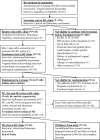Vaginal probiotic adherence and acceptability in Rwandan women with high sexual risk participating in a pilot randomised controlled trial: a mixed-methods approach
- PMID: 32434932
- PMCID: PMC7247375
- DOI: 10.1136/bmjopen-2019-031819
Vaginal probiotic adherence and acceptability in Rwandan women with high sexual risk participating in a pilot randomised controlled trial: a mixed-methods approach
Abstract
Objectives: To evaluate adherence and acceptability of intermittent vaginal probiotic or antibiotic use to prevent bacterial vaginosis (BV) recurrence.
Design: Repeated adherence and acceptability assessments using mixed methods within a pilot randomised controlled trial.
Setting: Research clinic in Kigali, Rwanda.
Participants: Rwandan women with high sexual risk.
Interventions: Women diagnosed with BV and/or trichomoniasis were randomised to four groups (n=17 each) after completing metronidazole treatment: behavioural counselling only, or behavioural counselling plus 2-month intermittent use of oral metronidazole, Ecologic Femi+ (EF+) vaginal capsule or Gynophilus LP (GynLP) vaginal tablet.
Outcome measures: Adherence and acceptability were assessed by structured face-to-face interviews, semi-structured focus group discussions and in-depth interviews, daily diaries and counting of used/unused study products in randomised women (n=68). Vaginal infection knowledge was assessed by structured face-to-face interviews in randomised women and women attending recruitment sessions (n=131).
Results: Most women (93%) were sex workers, 99.2% were unfamiliar with BV and none had ever used probiotics. All probiotic users (n=32) reported that insertion became easier over time. Triangulated adherence data showed that 17/17 EF+ users and 13/16 GynLP users used ≥80% of required doses (Fisher's exact p=0.103). Younger age (p=0.076), asking many questions at enrolment (p=0.116), having menses (p=0.104) and reporting urogenital symptoms (p=0.103) were non-significantly associated with lower perfect adherence. Women believed that the probiotics reduced BV recurrence, but reported that partners were sometimes unsupportive of study participation. Self-reported vaginal washing practices decreased during follow-up, but sexual risk behaviours did not. Most women (12/15) with an uncircumcised steady partner discussed penile hygiene with him, but many women found this difficult, especially with male clients.
Conclusions: High-risk women require education about vaginal infections. Vaginal probiotic acceptability and adherence were high in this cohort. Our results can be used to inform future product development and to fine-tune counselling messages in prevention programmes.
Trial registration number: NCT02459665.
Keywords: Africa; acceptability; adherence; bacterial vaginosis; vaginal probiotic.
© Author(s) (or their employer(s)) 2020. Re-use permitted under CC BY. Published by BMJ.
Conflict of interest statement
Competing interests: AN is employed by Biose (owner of trial product GynLP) and EL by Winclove Probiotics BV (owner of trial product EF+). AN has financial and/or intellectual investments in competing products.
Figures

References
Publication types
MeSH terms
Associated data
Grants and funding
LinkOut - more resources
Full Text Sources
Medical
